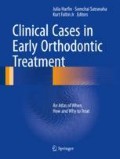Abstract
As it is known, upper central incisors erupt in most cases at 7 years old. Some factors such as, lack of space, supernumerary tooth, cysts or tumors will produce rotations. An early diagnosis will decrease the need of a complex treatment and prevent the situation worsens. The ideal timing to treat this malocclusion is when upper central incisors start to erupt, it can be done in many ways.The two most common options are fixed or removable appliances. After evaluating different alternatives it was proven that the best one is through fixed appliances. The advantage of this method is that treatment effectiveness will not depend on the patient.
Bibliography
Baccetti T. Tooth rotation associated with aplasia of non adjacent teeth. Angle Orthod. 1998;68:471–4.
Jahanbin A, Baghaii B, Parisay I. Correction of a severely rotated maxillary central incisor with the whip device. Saudi Dent J. 2010;22:41–4.
Kim YH, Shiere FR, Fogels HR. Pre-eruptive factors of tooth rotation and axial inclination. J Dent Res. 1961;40:548–57.
Parisay I, Boskabady M. Treatment of severe rotations of maxillary central incisors with whip appliance: report of three cases. Dent Res J (Isfahan). 2014;11(1):133–9.
Reitan K. Tissue rearrangement during retention of orthodontically rotated teeth. Angle Orthod. 1959;29(2):105–13.
Schneider E, Sabine R. Upper bonded retainers. Angle Orthod. 2011;81(6):1050–6.
Sanin C, Hixon EH. Axial rotations of maxillary permanent incisors. Angle Orthod. 1968;38(4):269–83.
Suresh M, Ratnaditya A, Kattimani VS, Karpe S. One phase versus two phase treatment in mixed dentition: a critical review. J Int Oral Health. 2015;7(8):144–7.
Swanson WD, Riedel RA, D’Anna JA. Post-retention study: incidence and stability of rotated teeth in humans. Angle Orthod. 1975;45:198–203.
Tsung-Ju H, Pinskaya Y, Roberts E. Assessment of orthodontic treatment outcomes: early treatment versus late treatment. Angle Orthod. 2009;75(2):162–17.
Vermeulen FM, Aartman IH, Kuitert R, Zentner A. The reliability of assessing rotation of teeth on photographed study casts. Angle Orthod. 2012;82:1033–9.
Author information
Authors and Affiliations
Corresponding author
Editor information
Editors and Affiliations
Rights and permissions
Copyright information
© 2017 Springer International Publishing Switzerland
About this chapter
Cite this chapter
Mana, M.F. (2017). Orthodontic Treatment of Atypically Rotated Central Incisor. In: Harfin, J., Satravaha, S., Faltin Jr, K. (eds) Clinical Cases in Early Orthodontic Treatment . Springer, Cham. https://doi.org/10.1007/978-3-319-46251-6_5
Download citation
DOI: https://doi.org/10.1007/978-3-319-46251-6_5
Published:
Publisher Name: Springer, Cham
Print ISBN: 978-3-319-46250-9
Online ISBN: 978-3-319-46251-6
eBook Packages: MedicineMedicine (R0)

